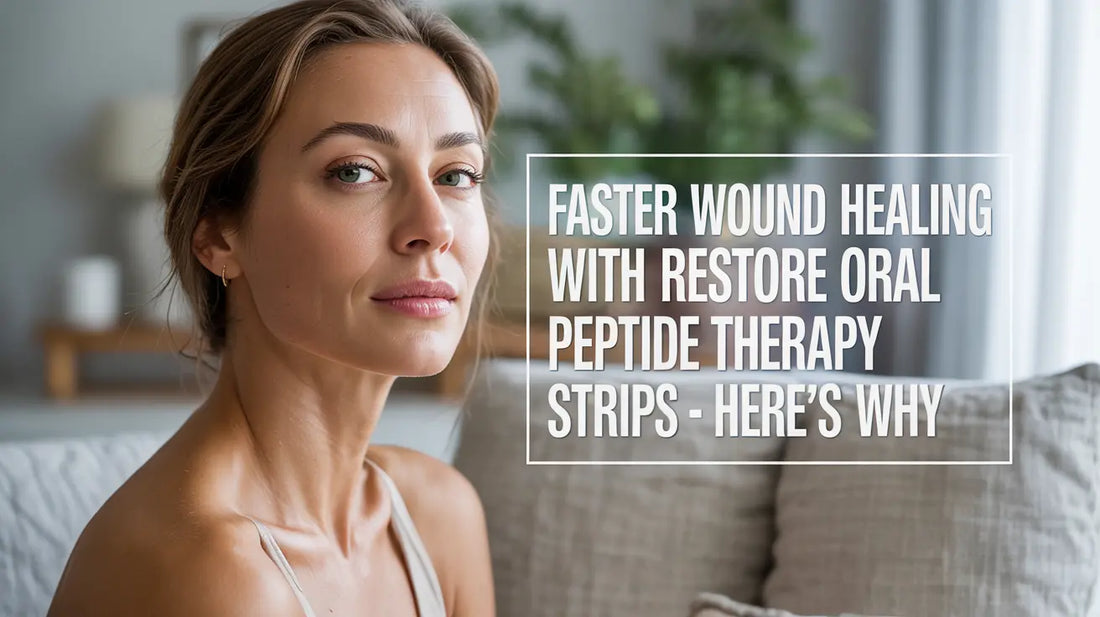
Faster Wound Healing with Restore Oral Peptide Therapy Strips - Here’s How
Share
Restore Oral Peptide Therapy Strips offer a superior, needle‑free approach that accelerates wound healing by enhancing angiogenesis, regulating inflammation, and supporting collagen remodeling for faster, more resilient tissue repair, without injections or topical creams.
In this article, you’ll learn:
- Angiogenesis: Building new blood vessels with peptides
- Scar Reduction: Reducing scar formation via BPC-157
- Delivery Methods: Peptide strips vs. topical creams for skin repair
- Chronic Wound Care: Healing chronic wounds & pressure ulcers
- Application Protocols: Protocol for applying Restore Blend for faster wound closure
- Safety Monitoring: Safety & monitoring: signs of effective healing
- Real-World Evidence: Before & after user stories and outcomes
Angiogenesis: Building New Blood Vessels with Peptides
Peptides like BPC-157 and TB-500 stimulate VEGF pathways to form microcapillaries in the wound bed:
- Enhances oxygen and nutrient delivery to regenerating tissue
- Speeds removal of cellular debris and supports endothelial cell migration
- Creates a robust vascular network that sustains long-term repair
*Dive deeper in *Mechanisms of Peptide-Driven Collagen Synthesis
Reducing Scar Formation via BPC-157
BPC-157 modulates collagen I/III ratios and MMP activity to minimize scarring:
- Balances matrix metalloproteinases (MMPs) and their inhibitors (TIMPs)
- Promotes organized collagen deposition for pliable, functional skin
- Limits hypertrophic and keloid scar development
TB-500 in Surgical Wound Recovery
TB-500 enhances cellular migration and structural remodeling following surgery:
- Guides fibroblasts and keratinocytes to incision sites for rapid closure
- Improves tensile strength of healed tissue through collagen cross-linking
- Reduces postoperative inflammation and downtime
Peptide Strips vs. Topical Creams for Skin Repair
Compare sublingual strips and topical formulations to choose the right delivery:
- Strips: Systemic support, consistent dosing, bypass digestive enzymes
- Creams: Targeted local concentration, direct application to wound edges
- Combine both for deep and surface-level repair strategies

Healing Chronic Wounds & Pressure Ulcers
Peptide therapy breaks the cycle of non-healing ulcers by addressing underlying deficits:
- Stimulates angiogenesis in hypoxic wound beds
- Regulates chronic inflammation that impedes closure
- Encourages extracellular matrix deposition in long-standing wounds
Protocol: Applying Restore Blend for Faster Wound Closure
Follow this regimen to optimize peptide action on wound sites:
- Acute Phase: Two strips daily (morning and evening) until re-epithelialization begins
- Maintenance Phase: One strip daily for 1–2 weeks post-closure
- Topical Adjunct: Apply peptide-infused cream twice daily to anoints margins
Safety & Monitoring: Signs of Effective Healing
Track these indicators to ensure successful recovery:
- Reduced Redness & Swelling: Inflammation subsides within days
- Granulation Tissue Formation: Healthy pink tissue appears by week two
- Scar Maturation: Softening and flattening over 4–6 weeks
- No Adverse Reactions: Monitor for excessive irritation or infection
Real-World Results: Before & After User Stories
Case studies demonstrate peptide-driven improvements:
- Diabetic Ulcer Closing: 45% size reduction in 3 weeks with BPC-157 strips
- Post-Surgical Scars: 60% scar-depth reduction at 8 weeks using TB-500 gel
- Pressure Ulcer Recovery: Complete closure in 4–6 weeks in chronic cases
Frequently Asked Questions
Here are some questions and answers:
How quickly will I see wound closure?
Most acute wounds show visible re-epithelialization within 3–5 days of peptide use.
Can peptides prevent all scars?
While they significantly reduce scar severity, genetic and wound-size factors also influence outcomes.
Are peptide strips safe on open wounds?
Yes—sublingual strips provide systemic support; combine with topical gels for direct application.
Should I use peptides for chronic ulcers?
Peptides can jumpstart healing in chronic wounds, but monitor closely and combine with standard care.
